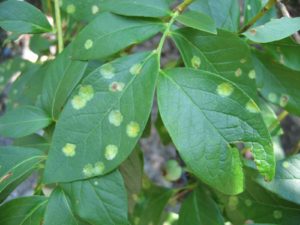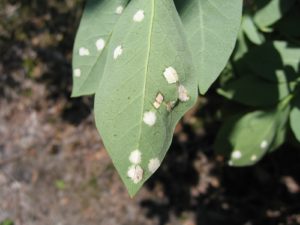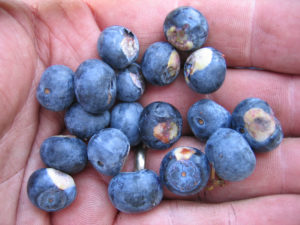Exobasidium Leaf and Fruit Spot
go.ncsu.edu/readext?604469
en Español / em Português
El inglés es el idioma de control de esta página. En la medida en que haya algún conflicto entre la traducción al inglés y la traducción, el inglés prevalece.
Al hacer clic en el enlace de traducción se activa un servicio de traducción gratuito para convertir la página al español. Al igual que con cualquier traducción por Internet, la conversión no es sensible al contexto y puede que no traduzca el texto en su significado original. NC State Extension no garantiza la exactitud del texto traducido. Por favor, tenga en cuenta que algunas aplicaciones y/o servicios pueden no funcionar como se espera cuando se traducen.
Português
Inglês é o idioma de controle desta página. Na medida que haja algum conflito entre o texto original em Inglês e a tradução, o Inglês prevalece.
Ao clicar no link de tradução, um serviço gratuito de tradução será ativado para converter a página para o Português. Como em qualquer tradução pela internet, a conversão não é sensivel ao contexto e pode não ocorrer a tradução para o significado orginal. O serviço de Extensão da Carolina do Norte (NC State Extension) não garante a exatidão do texto traduzido. Por favor, observe que algumas funções ou serviços podem não funcionar como esperado após a tradução.
English
English is the controlling language of this page. To the extent there is any conflict between the English text and the translation, English controls.
Clicking on the translation link activates a free translation service to convert the page to Spanish. As with any Internet translation, the conversion is not context-sensitive and may not translate the text to its original meaning. NC State Extension does not guarantee the accuracy of the translated text. Please note that some applications and/or services may not function as expected when translated.
Collapse ▲Exobasidium leaf and fruit spot has been reported from numerous locations in NC this year. The disease, caused by the fungus Exobasidium maculosum, is visible now on leaves, but will also infect berries, causing green spots on ripe fruit
 On leaves, spots are pale green on the upper surface but pure white below, with a thin, dense layer of fungal growth on the underside of the leaf. This fungal growth is most obvious on the underside of leaves, but can also occur on infected berries.
On leaves, spots are pale green on the upper surface but pure white below, with a thin, dense layer of fungal growth on the underside of the leaf. This fungal growth is most obvious on the underside of leaves, but can also occur on infected berries.  On berries, infection produces a green spot that fails to ripen normally. Affected berries do not leak or decay, but the green spot on an otherwise uniformly ripe berry is an unsightly defect that could lead buyers to reject the fruit.
On berries, infection produces a green spot that fails to ripen normally. Affected berries do not leak or decay, but the green spot on an otherwise uniformly ripe berry is an unsightly defect that could lead buyers to reject the fruit.
It is too late to prevent this disease in 2019. Treatment consists of spraying the bushes in late winter (February) with a lime-sulfur solution to kill the fungus where it overwinters on the surface of the stems. It is also possible to control this disease using a protectant fungicide like Captan sprayed repeatedly from budbreak through green fruit stage (February to April),
Most commercial growers treat routinely for this disease in fields where Exobasidium is known to occur. In the home garden it may make more sense to take a “wait and see” approach next year, since the disease is sporadic and may not recur. Like other Exobasidium diseases (such as azalea leaf gall and camellia leaf gall) this disease can be severe in one year, and nearly absent the next.


